Chawan Mushi (Japanese Savory Egg Custard)
My mom’s chawan mushi is absolutely my favorite Japanese dish. While I was pregnant last year, every time I visited my parents my Mom would ask me if I wanted her to make something to eat, and I would say, “CHAWAN MUSHI!”
Towards the end of my pregnancy my Dad refused to eat chawan mushi even though my Mom served it for dinner, and even Bebe Dada declined when I would bring home leftovers (I always asked my mom to make me extra, EXTRA servings).
I’ve been very spoiled until now because I only ate chawan mushi at my parent’s home and never felt like I needed to make it. Ever since I started my “family-cookbook-project-turned-blog” I’ve had this very strong desire to learn to cook my favorite childhood dishes for my family.
So last week, I finally gave chawan mushi a shot.
There are several steps to making chawan mushi and I commend my Mom for all those times she made this for us – and for me while I was preggo. I’ve numbered the steps, which I don’t usually do in my blog posts, but this one is a long one and I thought it would be easier to follow.
Mom’s Chawan Mushi
(Makes 4 – 5 chawan mushi, depending on the size of the dish you use)
For egg custard
- 3 eggs
- 2 1/4 cup water (including reserved shiitake liquid)
- 1 teaspoon katsuo dashi (bonito seasoning)
- 2 1/4 teaspoon shoyu (soy sauce)
- 3 – 4 small dried shiitake mushrooms
- 1/2 bunch of spinach
- 1/2 chicken breast
- 4 – 5 ginnan (gingko nuts) – optional
- 1/3 pink kamaboko ( or red fish cake)
For shiitake
- 2 cups water
- 2 teaspoon shoyu
- 1 1/2 teaspoon mirin
- 1/2 tablespoon sugar
1) Soak dried shiitake in 2 cups of warm water. Let soak for 15 – 20 minutes until mushrooms are tender. Reserve soaking liquid. Remove stems from the mushrooms. Cut mushrooms into quarters.
2) In a small pot, combine 1 cup of reserved shiitake liquid (save the remaining 1 cup for the egg custard), add shoyu, mirin, sugar and chopped shiitake and cook over medium heat. Stir constantly until liquid mostly evaporates. Leave mushrooms in pot until ready to use.
3) In a medium pot, combine 1 cup of reserved shiitake liquid, and 1 1/4 cup water. Bring to a boil then reduce to simmer. Add shoyu and katsuo dashi, stir then simmer for 5 minutes. My mom always uses dried dashi from the box that she buys at the Japanese supermarket because it saves time and has good flavor. (I have a homemade dashi recipe that I will post shortly.) Transfer the dashi to a bowl, and cool to room temperature. I just pop the bowl in the fridge for 20 minutes and then prep the rest of the ingredients.
4) While the dashi is cooling, bring water to a boil in a medium pot and blanch spinach leaves for 2 – 3 minutes. Remove spinach from pot and transfer to a colander. Run cold water over the spinach and then gently squeeze any excess water. Chop the spinach in half first, then chop into thirds that are about 3/4 inch long. Set spinach aside.
I bought pink Yamasa kamaboko (mom says this one is good for chawan mushi), although the package says “Red Kamaboko”. It’s really pink though (see for yourself below) but interestingly enough my mom calls this, “akai kamaboko” in Japanese which literally translates to red kamaboko. Anyway, moving along…
5) Separate the pink kamaboko from the wooden platform it rests on, by running a knife in between the kamaboko and the platform.
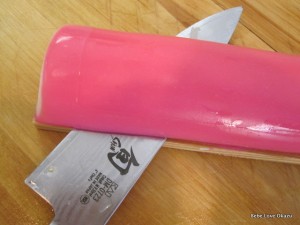
6) Then slice the pink kamaboko into desired thickness, and then cut each “fan” in half. You only need 4 slices to get 8 little pieces (2 for each dish). Set aside.
COOKING TIP: Kamaboko freezes well. I wrap 4 or 5 slices together in saran wrap and then put them in a ziplock bag so that I can use this for other dishes in the future. You’re probably getting the hint now that I like to store a variety of little things in my freezer – – – it’s my “frozen asian supermarket arsenal.” :)
My mom HATES ginnan with a passion.
Due to my imperfect bilingual Japanese – English upbringing, I never knew the English definition of ginnan until my 20’s, and when I was eating it (mostly during my trips to Japan), I didn’t know that the yellow bean I was eating, was actually ginnan. To make matters worse, my Japanese mother who mostly only speaks Japanese, didn’t know the English translation of ginnan so every time I asked her what that was she couldn’t tell me. Talk about “lost in translation” – no wonder I grew up so confused at times…
Anyway, in Japanese cooking, it is very common to find ginnan in chawan mushi. I’ve travelled to Japan several times over the years and every time I’m there, I eat as much chawan mushi as I can, and at the bottom of each chawan mushi, you’ll typically find a yellow bean – – – which turns out to be the ginnan my mom hates.
So, even though my mom NEVER adds this to her chawan mushi and I never ate this at home, I discovered a secret love for the little gingko nut and bought a can at Marukai. (Yikes. HUGE mistake.)
7) Rinse the ginnan before using, and set aside.
After I ate the canned ginnan in the chawan mushi I made, I decided I needed to find another brand of this stuff or completely omit it. (Sometimes using less ingredients makes the dish more affordable anyway.) The canned ginnan was not good at all. Maybe because I’m used to fresh ginnan… If you’re not a fan, just skip it for now. I’ll let you know when I find a good brand of ginnan. Or if you know of one, please leave me a comment, please!
8 ) Next, cut chicken breast (or leg if that’s all you have) into small bite sized pieces. It’s best to keep the chicken small because this will ensure that it cooks thoroughly when the chawan mushi is steamed.
9) In a large bowl, crack 3 eggs, one at a time, and remove the little white squiggly stuff, called “chalaza”. (Yes, I Googled this.) In case you’re wondering, chalaza is connective tissue linking the yolk to the lining membrane at each end of the shell. I’ve been learning so much because of my blog project!
It’s funny the stuff you forget from childhood, but then remember years later!
One of my jobs growing up was helping my mom remove the white squiggly stuff from the eggs when she made chawan mushi. I don’t think I helped with anything other than this menial task on chawan mushi night. As a kid, my mom gave me chopsticks to try to get it out. It took forever. Hmmmm… I think my mom gave me this task AND the chopsticks to intentionally keep me busy and out of her way.
When I cracked the eggs, I instinctively thought that I needed to remove the “chalaza”. I don’t do this for scrambled eggs or any other dish for that matter, but for some reason, I felt compelled to do this. I used a wooden spoon though, NOT chopsticks, and I got the squiggly stuff out in seconds.
10) Gently beat the eggs with chopsticks. Add the cooled dashi into the egg mixture and gently beat with chopsticks. I wasn’t so gentle – – – notice all the bubbles.
11) Assemble individual chawan mushi in desired dish. I used tea cups. My mom makes her chawan mushi in bigger yunomi (essentially an oversized tea cup that is taller and wider than a traditional Japanese tea cup) and if she ran out of those she would use big mugs. These were my fave because it meant I got a lot more chawan mushi, AND my mom usually put whatever extra ingredients she had leftover into these mugs so it was like a “super-sized” chawan mushi. :)
Layer ingredients from bottom to top:
- chicken
- ginnan (optional – I prefer my chawan mushi without this)
- kamaboko
- shiitake
- spinach
12) Pour egg and dashi mixture into the dish about 3/4 of the way full.
13) Bring water to a boil in the steamer, then reduce heat to simmer on low. Place egg custard dishes in the steamer. Only 3 dishes fit at a time in my steamer, so I needed to steam 2 batches.
14) Wet a dish towel and squeeze out excess water. Place this over the uncovered steamer, then put the lid of the steamer on top of the dish towel. Finally, fold over the excess towel on top of the steamer. Make sure the lid is on tightly.
I asked my mom why I had to wet the towel. She just said it creates a better seal when you close the lid. OK. I did as I was told since my mom’s been doing this for years and her chawan mushi always turn out great. (BUT, I’ve also used a dry dish towel and it works fine, but shhh don’t tell my Mom.)
15) Steam on low heat for 15 – 20 minutes until the egg custard sets. Let sit for 10 minutes. Serve and enjoy!
I hope one day bebe E will enjoy her bachan’s (grandma) chawan mushi recipe as much as I do. It’s a family classic and I’m looking forward to making this many times over! By the way, in case you’re wondering, it passed big onechan’s taste test. She ate a whole one by herself, with her standard seal of approval, “it’s good!”
Judy | bebe mama
- FOR EGG CUSTARD:
- 3 eggs
- 2¼ cup water (including reserved shiitake liquid)
- 1 teaspoon katsuo dashi (bonito seasoning)
- 2¼ teaspoon shoyu (soy sauce)
- 3 - 4 small dried shiitake mushrooms
- ½ bunch of spinach
- ½ chicken breast
- 4 - 5 ginnan (gingko nuts) - optional
- ⅓ pink kamaboko (fish cake)
- FOR SHIITAKE:
- 2 cups water
- 2 teaspoon shoyu
- 1½ teaspoon mirin
- ½ tablespoon sugar
- PREPARE SHIITAKE: Soak dried shiitake in 2 cups of warm water. Let soak for 15 - 20 minutes until mushrooms are tender. Reserve soaking liquid. Remove stems from the mushrooms. Cut mushrooms into quarters.
- In a small pot, combine 1 cup of reserved shiitake liquid (save the remaining 1 cup for the egg custard), add shoyu, mirin, sugar and chopped shiitake and cook over medium heat. Stir constantly until liquid mostly evaporates. Leave mushrooms in pot until ready to use.
- PREPARE DASHI: In a medium pot, combine 1 cup of reserved shiitake liquid, and 1¼ cup water. Bring to a boil then reduce to simmer. Add shoyu and katsuo dashi, stir then simmer for 5 minutes.
- While the dashi is cooling, bring water to a boil in a medium pot and blanch spinach leaves for 2 - 3 minutes. Remove spinach from pot and transfer to a colander. Run cold water over the spinach and then gently squeeze any excess water. Chop the spinach in half first, then chop into thirds that are about ¾ inch long. Set spinach aside.
- Separate the pink kamaboko from the wooden platform it rests on, by running a knife in between the kamaboko and the platform. Then slice the pink kamaboko into desired thickness, and then cut each "fan" in half. You only need 4 slices to get 8 little pieces (2 for each dish). Set aside. TIP: Kamaboko freezes well.
- If you are adding ginnan (gingko nuts), rinse the ginnan before using, and set aside.
- Next, cut chicken breast (or leg if that's all you have) into small bite sized pieces. It's best to keep the chicken small because this will ensure that it cooks thoroughly when the chawan mushi is steamed.
- In a large bowl, crack 3 eggs, one at a time, and remove the little white squiggly stuff, called "chalaza". I used a wooden spoon to remove it.
- Gently beat the eggs with chopsticks. Add the cooled dashi into the egg mixture and gently beat with chopsticks.
- Assemble individual chawan mushi in desired dish.
- Layer ingredients from bottom to top: chicken, ginnan, shiitake, kamaboko and spinach.
- Pour egg and dashi mixture into the dish about ¾ of the way full.
- Bring water to a boil in the steamer, then reduce heat to simmer on low. Place egg custard dishes in the steamer. NOTE: It's important to steam on low so that the custard doesn't bubble-up and over cook. If steamed at the right temperature, the top of the custard will look smooth and glossy.
- Wet a dish towel and squeeze out excess water. Place this over the uncovered steamer, then put the lid of the steamer on top of the dish towel. Finally, fold over the excess towel on top of the steamer. Make sure the lid is on tightly.
- Steam on low heat for 15 - 20 minutes until the egg custard sets. Let sit for 10 minutes.


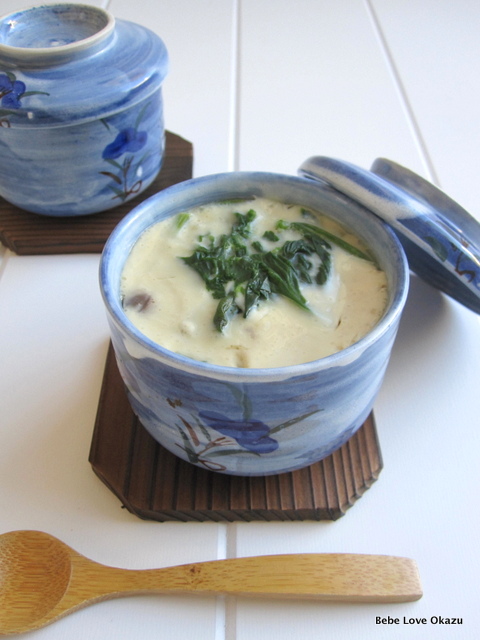
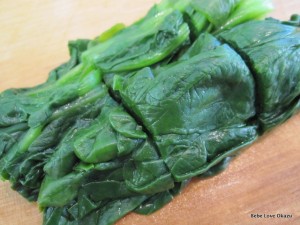
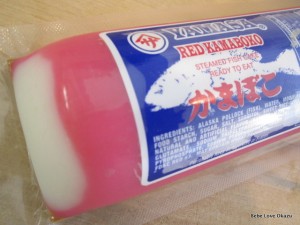
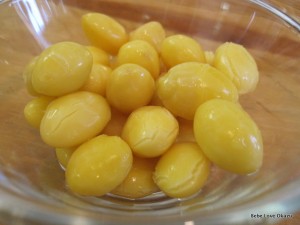
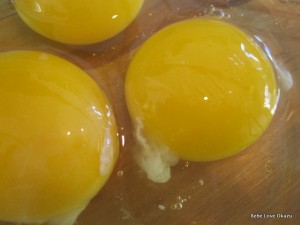
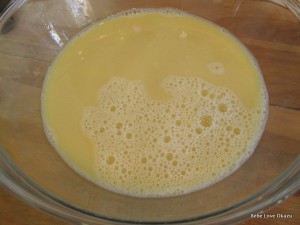
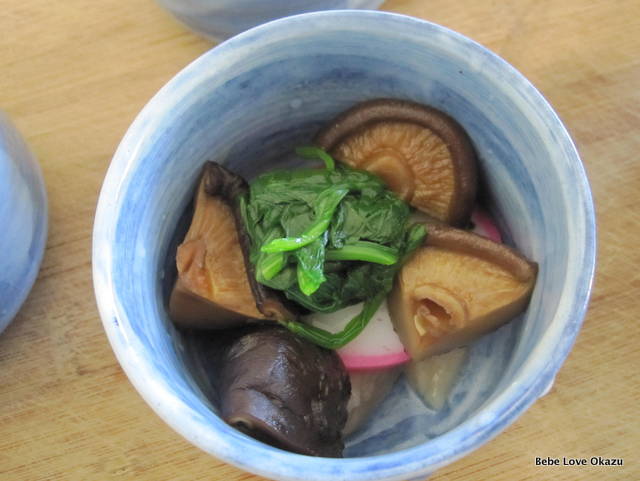
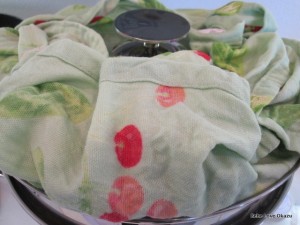
8 Comments